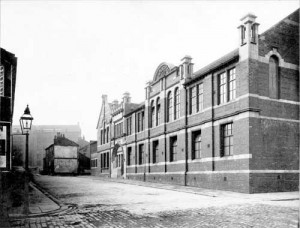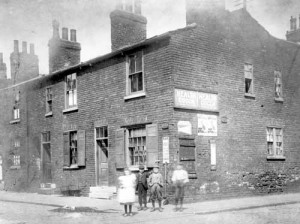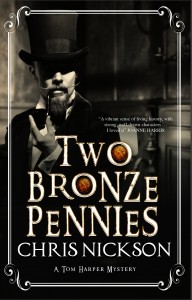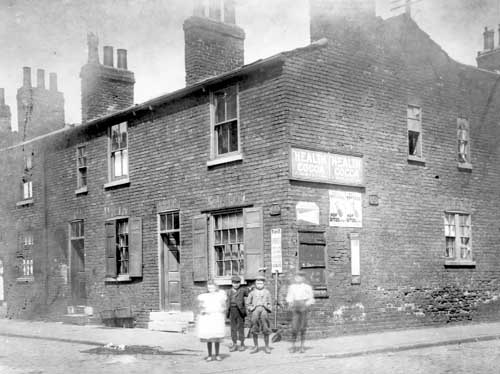This month Chris Nickson explores the history of the Jews in Leeds which informs his next novel, Two Bronze Pennies.
 There have been Jews in Leeds for over 250 years. In the 18th century there’s a reference to a man named Isaac the Jew. The name alone singles him out as someone very different from the rest of the Christian population. There’s no mention of whether he had a family or if he died here. He may have been the first Jew to make his home in Leeds, (although one Israel Benjamin who lived on Vicar Lane was buried in 1739 in Leeds Parish Church) but very far from the last.
There have been Jews in Leeds for over 250 years. In the 18th century there’s a reference to a man named Isaac the Jew. The name alone singles him out as someone very different from the rest of the Christian population. There’s no mention of whether he had a family or if he died here. He may have been the first Jew to make his home in Leeds, (although one Israel Benjamin who lived on Vicar Lane was buried in 1739 in Leeds Parish Church) but very far from the last.
Fast forward to 1840, when there were nine Jewish families – 56 people – identified in the census. They held their services in the loft of a house on Bridge Street and had their own cemetery. It was a while before the numbers of these immigrants increased. At that time, the main influx in Leeds came from Ireland, poor, desperate people settling in the squalid area known as the Bank – Richmond Hill as it is today.
It wasn’t until 1846 that Leeds had a real synagogue, a converted house on Back Rockingham Street that had an average attendance of 35. 14 years later came the first place built exclusively as a synagogue, on Belgrave Street – known for generations as the Great Synagogue.

The community began to grow. Originally made up of German immigrants, now the Jews came from farther East, places like Poland, Lithuania and Russia. They were trying to escape the grinding poverty of home, and even more, the pogroms that threatened to wipe them out. For many, England was meant to be no more than a staging post on the way to America. But in the end, many stayed – and many more came to join them.
They gathered and lived close to the synagogues in the area called the Leylands. It began just north of the city, around Templar Street, and ran most of the way to Sheepscar, with North Street as one boundary and what’s now Regent Street as the other – essentially a triangle of land where housing was cheap but far from pretty.
Many of the men worked as tailors. It was a trade that was portable, something of a prerequisite for people who never knew when they would have to leave and settle elsewhere. And the mid-1800s saw the rise of the tailoring industry here, the mass production of men’s clothing. In fact, it was an immigrant named Herman Friend who developed the assembly line style of tailoring that made John Barran so successful. But Friend was an outworker – not allowed to work in the factory because he was Jewish.
As the ready-made tailoring business boomed, the Jewish immigrants flocked into Leeds. The Jewish population had sky rocketed to 8,000 by 1891 and 14,000 a decade later, most of them crammed into the Leylands where they worked 12 hours and more a day in the sweatshops, creating garments. Yiddish was the lingua franca of the area, a common language joining those from different countries. A number of synagogues sprang up to cater for people of different backgrounds. And a growing number in the population were born in England.
There was still a huge amount of anti-Semitism in Leeds which followed from the anti-Irish feeling earlier in the century. Rooming houses and businesses posted ‘Jews Not Wanted’ signs. Cafes and pubs refused service, and that was perfectly legal in a time that held no anti-discrimination laws. They remained outsiders. Although they lived in Leeds, the world of the Leylands was very self-contained. By gathering together in what was really a ghetto, they had the safety of numbers. But with all the prejudice, they must have wondered how long before they had to leave again.
Much of daily life was run by the Jewish Board of Guardians who essentially liaised with the council. Board schools were built after the 1870 Education Act, which made school attendance compulsory; four of them went up in the Leylands for the burgeoning young population. They enjoyed the highest levels of attendance in England, and many pupils went on to obtain high school scholarships. For the immigrants, this was an opportunity for learning that they’d never enjoyed themselves.
It was a time when all the poor lived in terrible, unhygienic conditions, and when the workday, for adults and children, was 12 hours or more. Everyone suffered, make no mistake about that. By the beginning of the 20th century, the Jews were a large presence in Leeds, although there were plenty who would have preferred they had never arrived.

 Chris Nickson recently published Dark Briggate Blues, a noir mystery set in Leeds in the 1950s.
Chris Nickson recently published Dark Briggate Blues, a noir mystery set in Leeds in the 1950s.
His next novel, Two Bronze Pennies, is the second in the Detective Inspector Tom Harper series, taking place in 1890/91, against a backdrop of anti-Semitic violence and murder.

